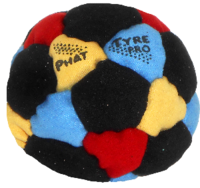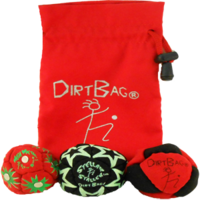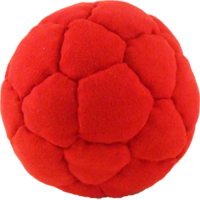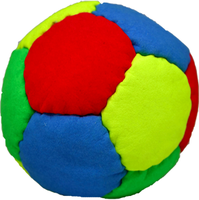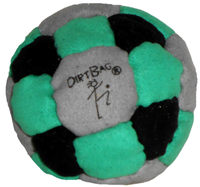The Worlds Leading Designers of High Quality Handmade Footbags & Juggling Balls
Please note that World Footbag and Flying Clipper have joined forces.
All orders placed on this website will ship from the World Footbag warehouse in Steamboat Springs CO.
Flying Clipper World Class Footbags and Juggling Balls
Thanks for stopping by Flying Clipper!
You can stay up-to-date with our monthly specials and discounts. Simple fill out the simple form below.
Close this box by clicking "No Thanks" below or clicking anywhere outside of the box.
Footbag and Juggle Ball Trivia & Thoughts
Plastic pellet filled footbags weigh in at 30 to 45 grams.
Sand filled footbags weigh in at 45 to 60 grams.
It takes twice as many individual stitches to produce a sand filled footbag verses a plastic pellet filled footbag to keep the sand inside the footbag.
All Flying Clipper footbags are hand sewn. It takes approximately 25 minutes per footbag of sewing time to produce one DirtbagŪ 8 footbag (a footbag with 8 panels). A DirtbagŪ 62 (yep, 62 panels) takes more than two hours to hand sew.
Footbags were originally made from cowhide, internally hand-stitched and filled with high density plastic pellets. It was common to have to look through a bin of 100 hacky sacksŪ to try and find the one that you thought you could break-in. The two piece construction of the original hacky sacks did not lend itself to a round sphere. We used to say that hacky sackŪ was proof positive that the egg came first!
Flying Clipper was among the first to branch out to create new and different designs focusing on roundness, durability and all around footbag play. We are the oldest continually operating footbag manufacturer on the planet.
While footbagging has always been our passion here at Flying Clipper, the natural extension was to combine feet and hands simultaneously, pushing the envelope as to what can be done using all four extremities to manipulate objects through space. Most footbaggers can juggle (as juggling has been around for thousands of years) while most jugglers do not footbag. The reason is that in the early days, footbags were very firm and not always round which made them hard to kick as a beginner. And as a beginner, juggling was easier to learn.
In the beginning footbags were always "kicked" and never "stalled," or stopped on the foot during play. And then Kenny Shults, a long time supporter of Flying Clipper, created delay moves using different sides of his feet. At last the footbag community had its "Michael Jordan." Other kickers picked up and carried on what Kenny Shults did in the pioneering portion of footbag as a sport. You see, until delay moves were created, the bridge between feet and hands could not be advanced. Stalling or delaying the footbag is the same movement done by the hands when juggling. That type of movement has advanced so far that some kickers and jugglers are now seamlessly juggling with combination of feet and hands.
Since its inception in the early 1980's Flying Clipper has also produced its line of juggle balls. Early on as with footbag, all balls were made by the partners, Reed, Dennis and Jim. More than 50,000 juggle balls were produced by the partners over an 18-year span. We know handmade juggling balls inside and out! Recently, with the addition of our TossaballŪ line of juggling balls and more recently the Hybrid line of juggle balls, using hand stitch techniques, we created a superior line of beanbags. Many pro jugglers are now coming to our TossaballŪ line of juggle balls (aka beanbags).
Now Flying Clipper has created a brand new way to make the first truly washable professional quality juggle ball. We call this new method of sewing our "Hybrid" line of juggle balls. Two layers of cover material are hand stitched together but with a twist: we trap heavy crushed rock between the two layers isolating most of the balls weight to the outside rim giving the ball unique qualities unlike any hand made beanbag before.
Sand filled footbags weigh in at 45 to 60 grams.
It takes twice as many individual stitches to produce a sand filled footbag verses a plastic pellet filled footbag to keep the sand inside the footbag.
All Flying Clipper footbags are hand sewn. It takes approximately 25 minutes per footbag of sewing time to produce one DirtbagŪ 8 footbag (a footbag with 8 panels). A DirtbagŪ 62 (yep, 62 panels) takes more than two hours to hand sew.
Footbags were originally made from cowhide, internally hand-stitched and filled with high density plastic pellets. It was common to have to look through a bin of 100 hacky sacksŪ to try and find the one that you thought you could break-in. The two piece construction of the original hacky sacks did not lend itself to a round sphere. We used to say that hacky sackŪ was proof positive that the egg came first!
Flying Clipper was among the first to branch out to create new and different designs focusing on roundness, durability and all around footbag play. We are the oldest continually operating footbag manufacturer on the planet.
While footbagging has always been our passion here at Flying Clipper, the natural extension was to combine feet and hands simultaneously, pushing the envelope as to what can be done using all four extremities to manipulate objects through space. Most footbaggers can juggle (as juggling has been around for thousands of years) while most jugglers do not footbag. The reason is that in the early days, footbags were very firm and not always round which made them hard to kick as a beginner. And as a beginner, juggling was easier to learn.
In the beginning footbags were always "kicked" and never "stalled," or stopped on the foot during play. And then Kenny Shults, a long time supporter of Flying Clipper, created delay moves using different sides of his feet. At last the footbag community had its "Michael Jordan." Other kickers picked up and carried on what Kenny Shults did in the pioneering portion of footbag as a sport. You see, until delay moves were created, the bridge between feet and hands could not be advanced. Stalling or delaying the footbag is the same movement done by the hands when juggling. That type of movement has advanced so far that some kickers and jugglers are now seamlessly juggling with combination of feet and hands.
Since its inception in the early 1980's Flying Clipper has also produced its line of juggle balls. Early on as with footbag, all balls were made by the partners, Reed, Dennis and Jim. More than 50,000 juggle balls were produced by the partners over an 18-year span. We know handmade juggling balls inside and out! Recently, with the addition of our TossaballŪ line of juggling balls and more recently the Hybrid line of juggle balls, using hand stitch techniques, we created a superior line of beanbags. Many pro jugglers are now coming to our TossaballŪ line of juggle balls (aka beanbags).
Now Flying Clipper has created a brand new way to make the first truly washable professional quality juggle ball. We call this new method of sewing our "Hybrid" line of juggle balls. Two layers of cover material are hand stitched together but with a twist: we trap heavy crushed rock between the two layers isolating most of the balls weight to the outside rim giving the ball unique qualities unlike any hand made beanbag before.

